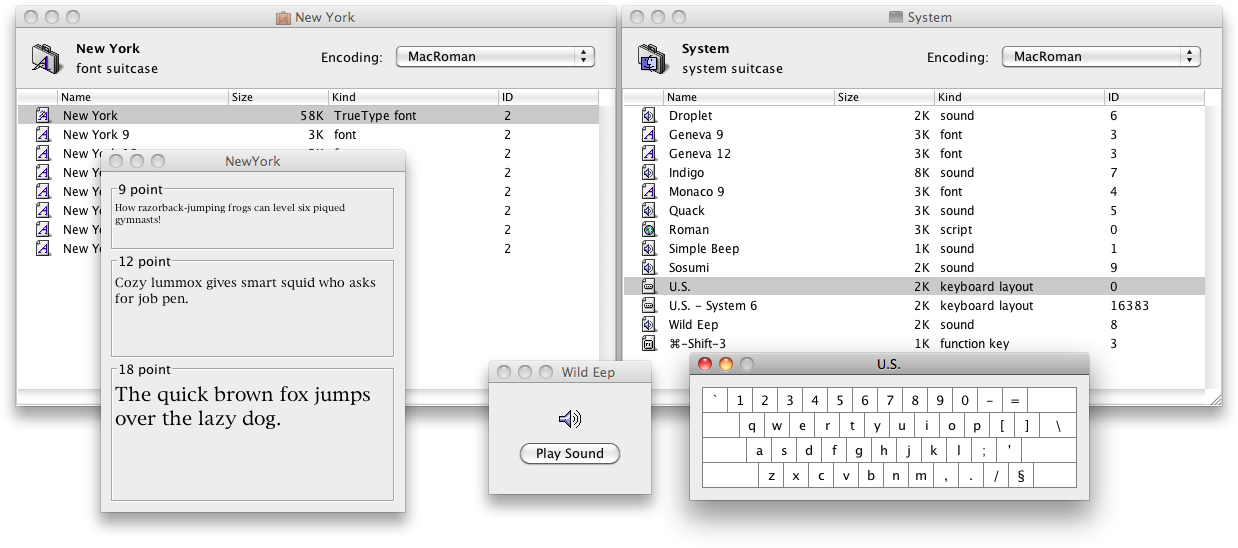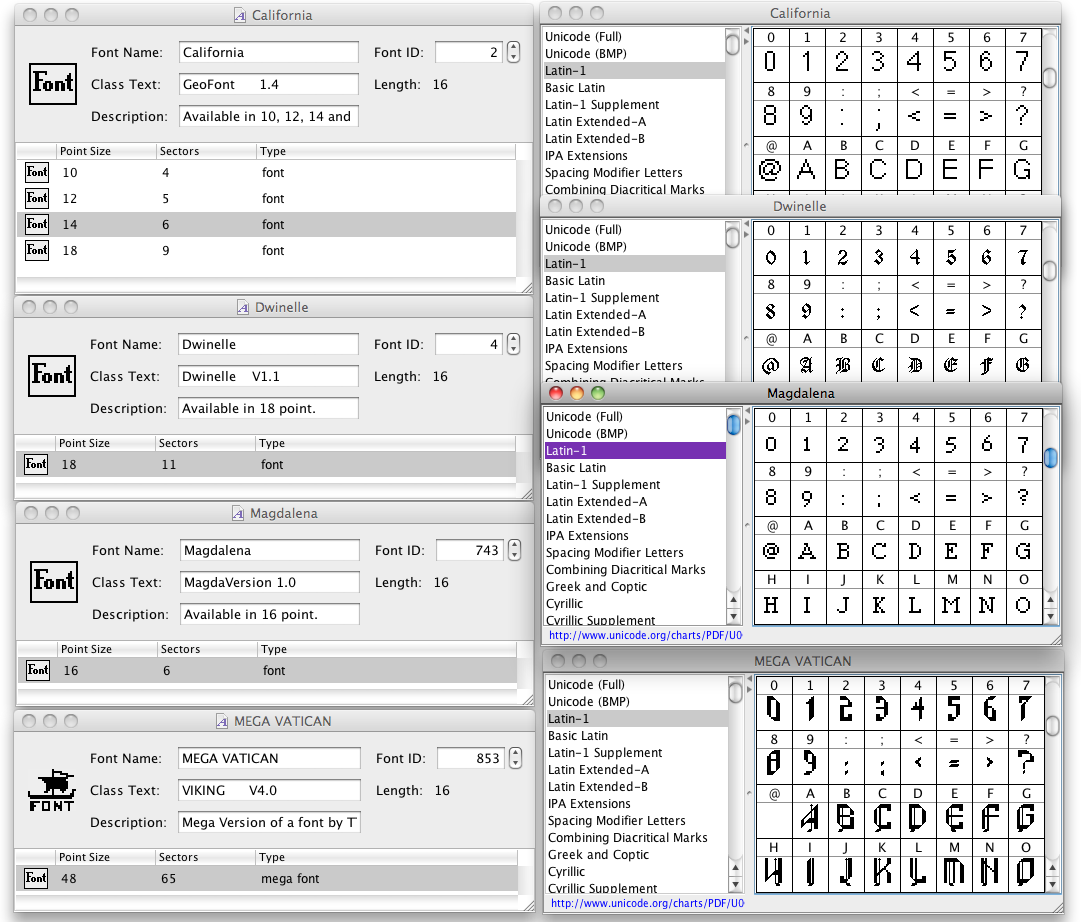Bits'N'Picas is a set of tools for creating and converting bitmap and emoji fonts.
Bitmap font functions can be accessed both with a GUI and from a command line. Emoji font functions can only be accessed from a command line.
Launch the Bits'N'Picas JAR without any arguments or with the edit command to open the bitmap font editor GUI.
java -jar BitsNPicas.jar
java -jar BitsNPicas.jar edit
java -jar BitsNPicas.jar edit myfont.sfd
The input format is determined by the file extension of the input file. Supported input formats include:
.kbits- Bits'N'Picas native save format.sfd- FontForge.bdf- X11 Bitmap Distribution Format.suit- Mac OS Classic font suitcase (in the resource fork).dfont- Mac OS Classic font suitcase (in the data fork).png- SFont or RFont, Kreative Software's extension of SFont.png,.jpg,.jpeg,.gif,.bmp- Create from image (GUI only).bin,.rom- Create from binary file (GUI only).hex- GNU Unifont hex format.cvt- GEOS font in Convert format (including MEGA fonts).fzx- FZX by Andrew Owen (for ZX Spectrum).u8m- U8/M (UTF-8 for Microcomputers).fnt- Windows.fntformat (not the same as.fon; vector fonts not supported).fnt,.ftx- IBM DOS/V FONTX2 format.fnt,.rbf,.rb11,.rb12- Rockbox Font Format.fnt,.fntz,.fnty,.cyf- Cybiko Font Format.hmzk- Mi Band 2 Font Format.dsf- DOSStart! by Daniel L. Nice.sbf- Sabriel Bitmap Font
On Mac OS X you can also launch or drop a font file onto the Bits'N'Picas application.
Bits'N'Picas can also open font, desk accessory, and system suitcases and move around fonts, desk accessories, scripts, keyboard layouts, and sounds, just like the Finder used to be able to do back in the good old days of System 7.
A similar interface also exists for GEOS fonts.
Example:
java -jar BitsNPicas.jar convertbitmap -f ttf -o myfont.ttf myfont.sfd
This will convert the bitmap strikes in the FontForge file myfont.sfd to outlines in a new TrueType font file myfont.ttf. If, for example, the bitmap strikes are 16 pixels in height, the generated outlines will perfectly match the pixel grid at a 16-point font size.
The input format is determined by the file extension of the input file. Supported input formats include:
.kbits- Bits'N'Picas native save format.sfd- FontForge.bdf- X11 Bitmap Distribution Format.suit- Mac OS Classic font suitcase (in the resource fork).dfont- Mac OS Classic font suitcase (in the data fork).png- SFont or RFont, Kreative Software's extension of SFont.hex- GNU Unifont hex format.cvt- GEOS font in Convert format (including MEGA fonts).fzx- FZX by Andrew Owen (for ZX Spectrum).u8m- U8/M (UTF-8 for Microcomputers).fnt- Windows.fntformat (not the same as.fon; vector fonts not supported).fnt,.ftx- IBM DOS/V FONTX2 format.fnt,.rbf,.rb11,.rb12- Rockbox Font Format.fnt,.fntz,.fnty,.cyf- Cybiko Font Format.hmzk- Mi Band 2 Font Format.dsf- DOSStart! by Daniel L. Nice.sbf- Sabriel Bitmap Font
The output format is determined by the -f option. Supported output formats include:
kbitsorkbnp- Bits'N'Picas native save formatttfortruetype- TrueTypebdf- X11 Bitmap Distribution Formatnfntorsuit- Mac OS Classic font suitcase (in the resource fork)dfont- Mac OS Classic font suitcase (in the data fork)pngorsfont- SDL SFontrfont- RFont, Kreative Software's extension of SFonthex- GNU Unifont hex formatcvtorgeos- GEOS font in Convert format (with MEGA option)fzx- FZX by Andrew Owen (for ZX Spectrum)u8m- U8/M (UTF-8 for Microcomputers)fnt,fnt3- Windows 3.x.fntformat (not the same as.fon)fnt2- Windows 2.x.fntformat (also not the same as.fon)fontx2,fontx, ordosv- IBM DOS/V FONTX2 formatrb12- Rockbox Font Format for Rockbox 2.3 or aboverb11- Rockbox Font Format for Rockbox 2.2 or below and iPodLinuxcybiko- Cybiko Font Formathmzk- Mi Band 2 Font Formatsbf- Sabriel Bitmap Font
Additional options include:
-sregex-rreplacement - Perform a search-and-replace on the font name.-b- Apply a faux-bold effect.-wunits-hunits - Specify the width and height of pixels in em units (forttfformat).-ifontid-zsize - Specify the font ID and font size (fornfntorgeosformat).
You can see a list of all options using the --help option.
java -jar BitsNPicas.jar extractsbix AppleColorEmoji.ttf
This will extract the images from AppleColorEmoji.ttf into the directory AppleColorEmoji.ttf.sbix.d as PNG files. There will be several numbered subdirectories within this directory; the number corresponds to the pixels per em of the images within. (This is not necessarily the same thing as the image height!) The resulting directory structure will look like:
AppleColorEmoji.ttf
AppleColorEmoji.ttf.sbix.d
20
glyph_43.png
glyph_44.png
...
32
glyph_43.png
glyph_44.png
...
...
java -jar BitsNPicas.jar extractsvg EmojiOne.otf
This will extract the SVG images from EmojiOne.otf into the directory EmojiOne.otf.svg.d as uncompressed SVG files. (If the SVG data inside the font is compressed, it will be decompressed.) The resulting directory structure will look like:
EmojiOne.otf
EmojiOne.otf.svg.d
glyph_2.svg
glyph_3.svg
...
java -jar BitsNPicas.jar extractcbdt NotoColorEmoji.ttf
This will extract the PNG images from NotoColorEmoji.ttf into the directory NotoColorEmoji.ttf.cbdt.d. There will be one or more numbered subdirectories within this directory; the number is simply the index of the BitmapSize record and has no other significance. The resulting directory structure will look like:
NotoColorEmoji.ttf
NotoColorEmoji.ttf.cbdt.d
0000
glyph_4.png
glyph_5.png
....
metadata.txt
....
fontinfo.txt
The metadata.txt file within each subdirectory lists all the values from the various data structures within the CBLC and CBDT tables. The fontinfo.txt file just lists some other values from other, unrelated tables for convenience (since many font editors cannot open fonts with CBDT/CBLC tables for you to find these values due to the lack of glyf/loca tables).
Microsoft's COLR/CPAL format is currently not supported.
To create an emoji/color font, you will need two things:
- A plain black-and-white TrueType font into which you intend to inject the color images.
- The accompanying directory of images, in the same structure and format as generated by the extraction process above.
java -jar BitsNPicas.jar injectsbix MyEmoji.ttf
This will take the TrueType font file MyEmoji.ttf and the images in the directory MyEmoji.ttf.sbix.d and generate a new TrueType font file MyEmoji.ttf.sbix.ttf with images embedded in an sbix table. You can then rename this file if you like. The name of each subdirectory within the image directory must be the pixels per em of the images it contains. (This is not necessarily the same thing as the image height!) The file name of each image within each subdirectory must be of the form glyph_123.png (with the glyph index in decimal) or char_ABCD.png (with the Unicode code point in hexadecimal). The bottom left position of each image will be determined by the minimum X and Y coordinates of the corresponding glyph in the TrueType font file. (For Apple Color Emoji, this just happens to be set to 0,0.)
java -jar BitsNPicas.jar injectsvg MyEmoji.otf
This will take the OpenType font file MyEmoji.otf and the SVG images in the directory MyEmoji.otf.svg.d and generate a new OpenType font file MyEmoji.otf.svg.otf with images embedded in an SVG table. You can then rename this file if you like. The file name of each image within the image directory must be of the form glyph_123_456.svg (for a range of glyphs, with the glyph indices in decimal), glyph_123.svg (for a single glyph, with the glyph index in decimal), or char_ABCD.svg (for a single glyph, with the Unicode code point in hexadecimal).
For each glyph index mapped to an SVG document, there must be an element in that document with an id corresponding to that glyph index (e.g. id="glyph123" for glyph index 123). Since you may not know the glyph index when specifying a code point in the image file name, you can use the placeholder id="glyph{{{0}}}" and it will be replaced with the appropriate glyph index during the injection process.
If you specify the -z option before the font file name, the SVG data will be compressed using GZIP. Microsoft claims the SVG-in-OpenType format supports this, and the availability of a version of EmojiOne with GZIP-compressed SVG glyphs appears to back this up. However, I was unable to get fonts with GZIP-compressed SVG glyphs to work even in the latest version of Firefox as of this writing, so I do not recommend this.
If you have a bunch of non-SVG images you would like to inject using this format, you can easily generate SVGs with embedded images using a command like the following:
java -jar BitsNPicas.jar imagetosvg -x 0 -y -700 -w 800 -h 800 myimages/*.png
This will create a corresponding SVG file for each non-SVG image file specified. The -x, -y, -w, -h options specify the position and size of the image in em units. Note that the SVG Y-axis is reversed from the TrueType Y-axis, so negative Y-coordinates are above the baseline and positive Y-coordinates are below the baseline.
java -jar BitsNPicas.jar injectcbdt MyEmoji.ttf
This will take the TrueType font file MyEmoji.ttf and the PNG images in the directory MyEmoji.ttf.cbdt.d and generate a new TrueType font file MyEmoji.ttf.cbdt.ttf with images embedded in a CBDT table. You can then rename this file if you like. There must be a subdirectory for each bitmap size; the names of the subdirectories do not matter. The file name of each image within each subdirectory must be of the form glyph_123.png (with the glyph index in decimal) or char_ABCD.png (with the Unicode code point in hexadecimal).
It is recommended for each subdirectory to also contain a metadata.txt file of values to use for the various data structures within the CBLC and CBDT tables. The following is recommended at a minimum:
horiAscender: *ascent in pixels (normally positive)*
horiDescender: *descent in pixels (normally negative)*
horiWidthMax: *max character width in pixels*
vertAscender: *ascent in pixels (normally positive)*
vertDescender: *descent in pixels (normally negative)*
vertWidthMax: *max character width in pixels*
ppemX: *pixels per em*
ppemY: *pixels per em*
glyph: *glyph index*
height: *image height in pixels*
width: *image width in pixels*
bearingX: *x offset in pixels*
bearingY: *y offset in pixels (positive is above the baseline)*
advance: *character width in pixels*
endGlyph
For the glyph index you can also use char_ABCD (with the Unicode code point in hexadecimal) or * to cover all glyphs not otherwise specified. Fields associated with the data structure itself (various offsets, counts, and glyph index ranges, as well as anything associated with the various types of index subtables) do not need to be specified, will be ignored if specified, and will be calculated automatically. (Only index subtable format 1 and bitmap data formats 17, 18, and 19 will be used, regardless of the metadata specified.)
By default, injectcbdt will also remove any glyf, loca, CFF , or CFF2 tables from the font. To keep these tables, specify the -g option before the font file name.
Microsoft's COLR/CPAL format is currently not supported.


